Citation: Jade Sternberg, Miriam Wankell, V. Nathan Subramaniam, Lionel W. Hebbard. The functional roles of T-cadherin in mammalian biology[J]. AIMS Molecular Science, 2017, 4(1): 62-81. doi: 10.3934/molsci.2017.1.62
| [1] | Shufen Zhao, Xiaoqian Li, Jianzhong Zhang . S-asymptotically ω-periodic solutions in distribution for a class of stochastic fractional functional differential equations. Electronic Research Archive, 2023, 31(2): 599-614. doi: 10.3934/era.2023029 |
| [2] | Seda IGRET ARAZ, Mehmet Akif CETIN, Abdon ATANGANA . Existence, uniqueness and numerical solution of stochastic fractional differential equations with integer and non-integer orders. Electronic Research Archive, 2024, 32(2): 733-761. doi: 10.3934/era.2024035 |
| [3] | Changling Xu, Huilai Li . Two-grid methods of finite element approximation for parabolic integro-differential optimal control problems. Electronic Research Archive, 2023, 31(8): 4818-4842. doi: 10.3934/era.2023247 |
| [4] | Jingyun Lv, Xiaoyan Lu . Convergence of finite element solution of stochastic Burgers equation. Electronic Research Archive, 2024, 32(3): 1663-1691. doi: 10.3934/era.2024076 |
| [5] | Meng Gao, Xiaohui Ai . A stochastic Gilpin-Ayala nonautonomous competition model driven by mean-reverting OU process with finite Markov chain and Lévy jumps. Electronic Research Archive, 2024, 32(3): 1873-1900. doi: 10.3934/era.2024086 |
| [6] | Martin Bohner, Alexander Domoshnitsky, Oleg Kupervasser, Alex Sitkin . Floquet theory for first-order delay equations and an application to height stabilization of a drone's flight. Electronic Research Archive, 2025, 33(5): 2840-2861. doi: 10.3934/era.2025125 |
| [7] | Jing Yang, Shaojuan Ma, Dongmei Wei . Dynamical analysis of SIR model with Gamma distribution delay driven by Lévy noise and switching. Electronic Research Archive, 2025, 33(5): 3158-3176. doi: 10.3934/era.2025138 |
| [8] | Kai Gao . Global boundedness of classical solutions to a Keller-Segel-Navier-Stokes system involving saturated sensitivity and indirect signal production in two dimensions. Electronic Research Archive, 2023, 31(3): 1710-1736. doi: 10.3934/era.2023089 |
| [9] | Dongxing Fu, Xiaowei Xu, Zhibing Zhao . Generalized tilting modules and Frobenius extensions. Electronic Research Archive, 2022, 30(9): 3337-3350. doi: 10.3934/era.2022169 |
| [10] | Zihan Zheng, Juan Wang, Liming Cai . Global boundedness in a Keller-Segel system with nonlinear indirect signal consumption mechanism. Electronic Research Archive, 2024, 32(8): 4796-4808. doi: 10.3934/era.2024219 |
Landslides are natural processes that can be triggered directly or indirectly by natural and/or human activities. Natural activities include high rainfall, earthquakes and volcanic eruptions [1], and human activities include land-use change, deforestation, excavation, change in the slope profile, and irrigation [2]. Indirect effects could result from changes in rainfall associated with an increase in surface water area. Landslides are devastating to human activities, thus predicting their occurrence and effect is critical. An established tool for this is Landslide Risk Maps (LRMs). LRMs is an outcome of Landslide Hazard Maps (LHMs), but producing both LRMs and LHMs requires information which may be difficult to obtain (such as detailed geological maps, landslide inventory maps, historical records, rainfall records and earthquake magnitudes). A practical alternate is a Landslide Susceptibility Map (LSMs).
LSMs map potential landslide areas [3]. Landslide susceptibility is determined by several related, spatially-distributed factors (e.g. geology, slope angle, slope aspect, drainage, etc.), pertinent to instability. The landslide susceptibility of any area has usually been categorized in the range "stable to unstable", thus indicating landslide-prone areas [4,5].
In 1979, an early form of LSMs at the scale 1:125.000, was prepared of the San Francisco Bay region according to slope units, rock lithologies, susceptible bedrock, susceptible superficial deposits and landslide deposits [6]. Nilsen and Wright combined slope angle and rock lithology categories and classified the region into five areas: (1) stable, (2) generally stable, (3) moderately stable, (4) moderately unstable, and (5) unstable [3]. In general, various approaches have been developed to evaluate landslide susceptibility [7] and landslide hazard for the regional scale (e.g. river basin) [8,9,10,11].
Brabb circulated a questionnaire to international experts concerning the availability of landslide inventory maps to celebrate the start of the International Decade of Reduction of Natural Hazards (1991–2000) [12]. The result showed that most countries had landslide inventory maps with national coverage at less than 25% except Austria, Hungary, Korea, Taiwan, Hong Kong, New Zealand, Canada and Costa Rica [3].
Later, geoscientists in many countries started preparing landslide maps with the help of GIS [13,14,15]. Up to now, many research and educational institutes and commercial companies have been offering information on geological hazards, particularly landslides. This arises from a widespread application of GIS and remote sensing techniques. Emergence of GIS applications in landslide map generation is critical by this time.
Various studies have been conducted on landslide susceptibility mapping [1,4,6,8,15,16,17,18,19,20,21,22]. A rating was determined taking into account the ratio of the total aspect and slope of topography and the aspect and slope of topography per grid interval where the landslide occurred in the Janghung area of South Korea. Finally, the rating was summed to calculate the landslide susceptibility index (LSI) per grid cell [16,17]. Colorado State University proposed debris flow hazard susceptibility mapping at a scale 1:24.000, prepared using an algorithm taking into account the influence of factors such as slope angle, slope orientation, Unified Soil Classification System (USCS), clay content and clay's geotechnical and erosive properties [23]. With the help of a raster GIS, [24] used a weighting factor procedure to produce a landslide susceptibility map (LSM) in the Wondogenet area in the eastern Ethiopian rift. Landslide susceptibility assessments were performed using landslide occurrence data, and layers representing lithology, drainage network, geology, slope angle, slope aspect and vegetation cover. Weightings were assigned with regard to the observed landslide intensities for each class, resulting in LSMs. In this case, a landslide hazard map was subsequently created by overlaying the susceptibility maps; the values of each grid cell in the contributing layers were summed and divided by the total number of controlling parameters [3]. Zhu et al. integrated human expertise on landslide-environment relationships with GIS under fuzzy logic. Geology, slope and strata, slope gradient, relative relief and slope shape were used as rule set to conduct landslide susceptibility in Three Gorges area (China) [25]. Authors validated their analysis by examining the usefulness of the fuzzy membership values. They used 21 landslides and the computed fuzzy membership value for susceptibility at each site was obtained from the derived fuzzy membership map.
In recent decades, several studies on landslide susceptibility mapping have been carried out in Italy. Orthophotos of southern Italy were used to determine landslide areas to form landslide inventory maps [21]. Magliulo et al. used lithology, landuse, slope gradient and aspect to prepare LSMs. These LSMs compared well with a geomorphological map. To obtain a LSM, a landslide occurrence map is required to evaluate landslide related data statistically. An occurrence map is used together with data such as geology, slope, aspect, drainage, etc. to determine potential landslide sites which have the same conditions as those on the occurrence map. Landslide susceptibility analysis requires a large amount of data as input, thus making high budgetary and time demands [20]. Kıncal et al. carried out landslide susceptibility assessment in Izmir city (Turkey) using the variables of lithology, slope gradient, slope aspect, distance to drainage, distance to roads and distance to fault lines in logistics regression analysis. Lithology played the most important role in determining landslide occurrence and distribution on the basis of the provided coefficients [26].
Bai et al. prepared a detailed landslide susceptibility map in the Zhongxian segment in the Three Gorges area of China using logistic regression method with the help of Geographical Information Systems (GIS). Statistical relationships for landslide susceptibility were conducted using landslide and landslide triggering factors [27]. Seed cells were used to be dependent variable in order to create a reliable logistic regression model. The seed cells were formed from landslide boundaries and represented the pre-failure undisturbed morphological conditions. Yilmaz et al. [used statistical index (Wi) method of Van Westen to conduct landslide susceptibility in Devrek (Zonguldak/Turkey) [28,29]. Ten parameters of elevation, slope, aspect, profile curvature, plan curvature, distance to streams, drainage density, distance to ridges, distance to road and power line network, and lithology were used during the analyses. Seed cells of Süzen and Doyuran were used to define decision rules of slope instabilities and percentile class divisions [30]. In all data sets authors used, elevation, lithology, slope aspect and drainage density were found as critical parameters for landslide occurrence. Chen et al. prepared a landslide susceptibility map in the Zigui segment of the Three Gorges area of China by using light detection and ranging (LiDAR) and logistic regression model (LRM) [31]. After processing LiDAR & DMC data and geological maps and landslide-controlling factors were derived as landslide density, digital elevation model (DEM), slope angle, aspect, lithology, land use and distance from drainage. The likelihood ratio (LR) analysis then applied to find correlation between the landslide locations and landslide-controlling factors. Logistic Regression Model (LRM) was used to predict the occurrence of landslides. Wu et al. used rough sets and back-propagation neural networks (BPNNs) to map landslide susceptibility on the Zigui-Badong of the Three Gorges area [32]. Landslide inventory map was prepared with the help of field works. Twenty-two landslide related parameters were created using topographical and geological maps, Landsat ETM+ and HJ-A satellite images. Elevation, slope, profile curvature, catchment aspect, catchment height, distance from drainage, engineering rock group, distance from faults, slope structure, land cover, topographic wetness index, and normalized difference vegetation index were used as independent variables set by the rough set and correlation coefficient analysis. Three layered and four layered BPNN were trained and used to obtain landslide susceptibility map. Kavzaoglu et al. prepared nine thematic maps associated with lithology, slope, aspect, land cover, drainage density, topographic wetness index, elevation, slope length and distance to road to create landslide susceptibility map with the help of multi-criteria decision analyses (MCDA) and support vector regression (SVR) methods for the province of Trabzon (Turkey) [33]. Performances of the methods were compared with logistic regression model. Tehrany et al. used weights-of-evidence (WoE) model to assess the impact of classes of each conditioning factor on flooding through bivariate statistical analysis (BSA) [34]. Their WoE model was integrated with SVM in order to enhance the performance of each method. Also, increasing the accuracy of the flood susceptibility map to properly manage the prone area of the floods, is aimed. Wu et al. used object based data mining methods were applied to a case study of landslide susceptibility assessment on the Guojiaba Town of the Three Gorges area [35]. Eleven landslide related factors were extracted using satellite images, topographical and geological maps. These factors were calculated as independent variables using significance testing and correlation coefficient analysis including slope, profile curvature, engineering rock group, slope structure, distance from faults, land cover, tasselled cap transformation wetness index, reservoir water level, homogeneity, and first and second principal components of the images. Decision tree and SVM models were used to prepare landslide susceptibility map. Du et al. used support vector machine (SVM) to produce landslide susceptibility maps for the Daguan County of Zhaotong City (Yunnan Province/China) [36]. Landslide conditioning parameters of slope angle, slope aspect, altitude, distance to faults, distance to rivers, and distance to roads, NDVI, rainfall and lithology were used during the analysis. SVM model was validated by using area under the curve (AUC) methods. The validation results authors obtained showed high accuracy (84.73%).
In this paper, we present a landslide susceptibility map as a case study for the Badong County in Three Gorges (TG) region of China to use geology, slope aspect, slope angle, drainage network, lineament and vegetation cover data from Landsat imagery, ASTER imagery and a GDEM to create a Vector Grid File (VGF) (= Vector pixel) based GIS model. Then, we compare this VGF-based LSM with the deformation signals derived using Persistent Scatter Interferometric Synthetic Aperture Radar (PS InSAR).
The study area, located in the TG region (China, Figure 1), is well known for its dam construction. The TG dam is the largest water management project in the world today. The total catchment area of TG project is about 1.0 × 106 km2 with 4.5 × 1011 m3 the average annual runoff [37]. It is claimed that the main functions of the TG dam include flood control and hydro-electric power. This dam is the most important flood control project built on the Yangtze River. The flood season of the Yangtze River is between June and September during which 70% to 75% of the total annual rainfall occurs. Historical records show that 214 floods occurred in the Yangtze Valley between the beginning of the Han Dynasty (206 B.C.) and the end of the Qing Dynasty (1911 A.D.), i.e. about one per decade [38]. Since the 1920s, flood hazards have threatened more than 1.5 million ha of crops, 15 million people and their properties and railway transportation. The normal water level and the total storage capacity of the dam are 175 m and 3.93 × 1010 m3, respectively. The water level is reduced to 145 m to control any harmful effects of floods on the dam structure.
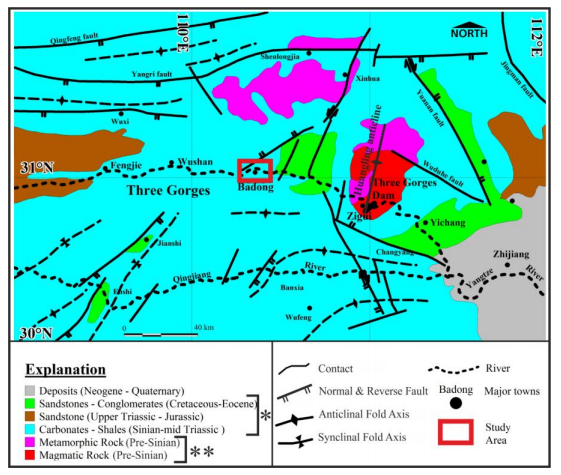 Figure 1. Geology and tectonic setting map of Three Gorges region (Modified from [39]) (** : Presinian crystalline basement, * : Sinian-Eocene sedimentary cover series).
Figure 1. Geology and tectonic setting map of Three Gorges region (Modified from [39]) (** : Presinian crystalline basement, * : Sinian-Eocene sedimentary cover series).There are frequent precipitation-related hazards in the TG region. More than 30, 000 people died in a huge flood on the Yangtze in 1954, in which 90 percent of the 30, 000 deaths were disease related [40]. At least 2, 000 km2 of farm land were flooded and more than 1, 500 people lost their lives because of the flood in 1998 [41]. In 2008, heavy precipitation led to serious storm and flood disasters such as the collapse or flooding of rural homes, destruction of cropland, heavy loss of livestock and poultry farms and damage to urban and rural roads [42]. Other frequent natural hazards in this region are geological disasters, such as landslides and mud flows. It was reported that 34 counties in Chongqing had suffered from collapse, landslide and rock and mud flow [43]. The impounding of the TG dam reservoir was started on April 1, 2003 [37]. From this time, the water level of the Yangtze River rose and TG Dam Lake was created. Landsat images can be used to display water level change from 2000 to 2006 (Figure 2).
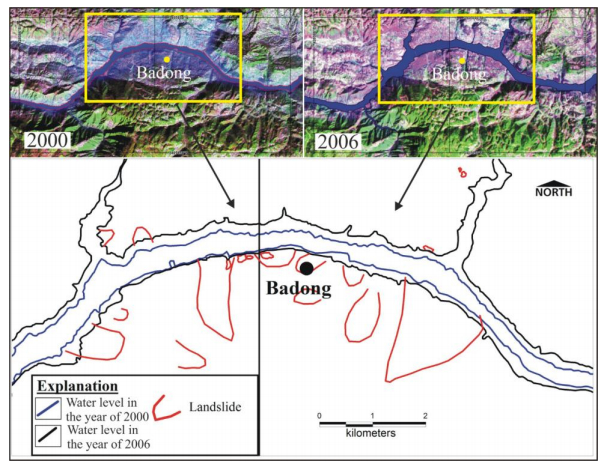 Figure 2. Water level change in the Yangtze River in the years 2000 and 2006. (Locations of the large landslides were extracted from [44]).
Figure 2. Water level change in the Yangtze River in the years 2000 and 2006. (Locations of the large landslides were extracted from [44]).Many landslides occurred near the water level of the Yangtze River and more than 97% of landslides were on the main channel of the TG region (Figure 2 and 3). Some landslides, such as those in Wanxian County where is nearly 190 km far from the study area in the southwest-west direction, occurred at different elevation ranges and with sliding surfaces following the nearly horizontal rock stratums (Figure 3) [45]. Slope instabilities already threaten several new towns and the rising water level in the reservoir has the potential to trigger old instabilities as well as create new ones [39].
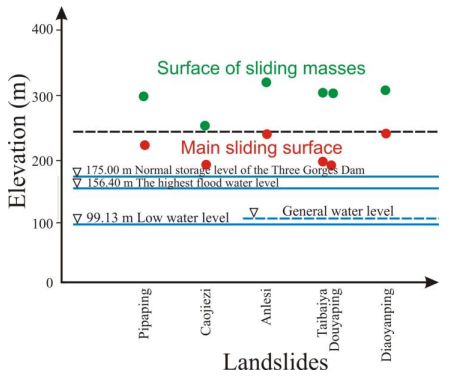 Figure 3. Elevation ranges of the old landslides that have occurred in Wanxian County (modified from [42]).
Figure 3. Elevation ranges of the old landslides that have occurred in Wanxian County (modified from [42]).A field trip was carried out in the Badong County to check surface movements and cracks have occurred on the man-made structures (Figure 4). This field work showed that landslides in the area are still active. Cracks were recorded on some roads which were built in 2006 and 2007.
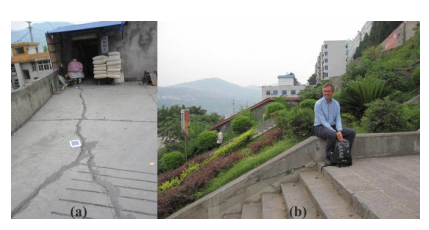 Figure 4. (a) A view of surface cracks seen in a landslide field in Badong County; (b) Surface displacements observed in a landslide field in Badong County.
Figure 4. (a) A view of surface cracks seen in a landslide field in Badong County; (b) Surface displacements observed in a landslide field in Badong County.The geological setting of the area consists of two major formations, a Pre-Sinian crystalline basement and a Sinian-Eocene sedimentary cover series (Carbonates, shales, sandstones and conglomerates) (modified from [46]). The crystalline basement is composed of metamorphic and magmatic rocks and the sedimentary cover is composed of interbedded sandstone, shale and claystone intercalations.
The Huangling anticline is the major folding system in the area. It is 50 km in length, lying to the southeast of Zigui, with Pre-Sinian metamorphic and magmatic rocks forming the fold's core [39]. The reason for building the TG Dam in its present location is the strength and stability of this anticlinal structure and the lack of any significant earthquakes in this area [37] (Figure 1).
The southern Zigui and Badong area is characterised by secondary faults, consistent with the ENE–WSW oriented fold system [47]. Weak zones were formed by the secondary fault and fracture systems which trigger slope instability.
A detailed investigation has been performed mainly involving remotely sensed Landsat ETM+ and ASTER images, SAR interferometric processing, LSM and validation. PS InSAR data was used to validate analyses performed. Our GIS-model is based on the information provided by ASTER and Landsat TM and ETM+ images, ASTER GDEM data, published literature and limited field observations.
Data from the NASA Earth Observing System (EOS) satellite-based instruments offer many resources for collecting high spatial and temporal resolution information related to urban and non urban areas. ASTER on board the Terra platform is well-suited for geological analysis [48]. The ASTER instrument was built by Japan's Ministry of Economy, Trade and Industry (METI) and launched onboard the NASA's Terra spacecraft in December 1999. It has an along-track stereoscopic capability using its infrared spectral bands and its nadir-viewing and backward-viewing telescopes to acquire stereo images with a base-to-height ratio of 0.6. One nadir-looking ASTER Very Near Infrared (VNIR) scene consists of 4, 100 samples by 4, 200 lines [49]. ASTER data can be used for analysing and investigating urban land cover/land-use and biophysical parameters such as biomass, spatial metrics and surface temperature/emissivity [50,51,52]. In this study, two Terra ASTER Level 1A images acquired on July 17, 2000 and September 25, 2002 were used.
The Landsat Thematic Mapper (TM), a sensor carried onboard Landsats 4 and 5, has acquired images of the Earth from July 1982. The temporal resolution of TM is sixteen days [53]. Landsat 7 was launched on April 5, 1999. The Earth observing instrument on Landsat 7, the Enhanced Thematic Mapper Plus (ETM+), extends the capabilities of the highly successful Thematic Mapper instruments on Landsat 4 and 5 [54]. The scene size is 170 km in the north-south and 183 km in the east-west directions. Landsat images have been resampled using cubic convolution (CC). Four Landsat images acquired on April 17, 1987, May 14, 2000, November 6, 2000 and September 12, 2006 were used in this study (Table 1). Landsat images were used in this study to map water level changes of the Yangtze River and prepare geological and vegetation maps.
| Acquire Date | Dataset | Cloud cover (%) | Path/Row | Number of Bands | Spatial resolution | Cover area (km) |
| 1987-04-17 | Landsat TM | 0 | 125/39 | 7 | Band 6 = 120 m Other bands = 30 m | 170 × 183 |
| 2006-09-12 | Landsat TM | 0 | 125/39 | 7 | ||
| 2000-05-14 | Landsat ETM+ | 0 | 125/39 | 8 | Band 6L=60 m Band 8 = 15 m Other bands=30 m | |
| 2000-11-06 | Landsat ETM+ | 0 | 125/39 | 8 | ||
| 2000-07-17 | ASTER | 3 | 125/39 | 14 | Bands 1, 2, 3N and 3B = 15 m Bands 4-9 = 30 m Bands 10-14 = 90 m | 60 × 60 |
| 2002-09-25 | ASTER | 5 | 125/39 | 14 |
In this study, geological boundaries were visually interpreted using Landsat TM 7-3-1, 7-4-1 and ETM+ 7-3-1 and 7-4-2 data. Screen digitisation was performed during the preparation of a geological map. ASTER band combinations of different channels 3-2-1, 4-6-9 and 4-6-12 images were then employed to correct some contacts of the formations (Figures 5 and 6). Details of the satellite images are given in Table 1.
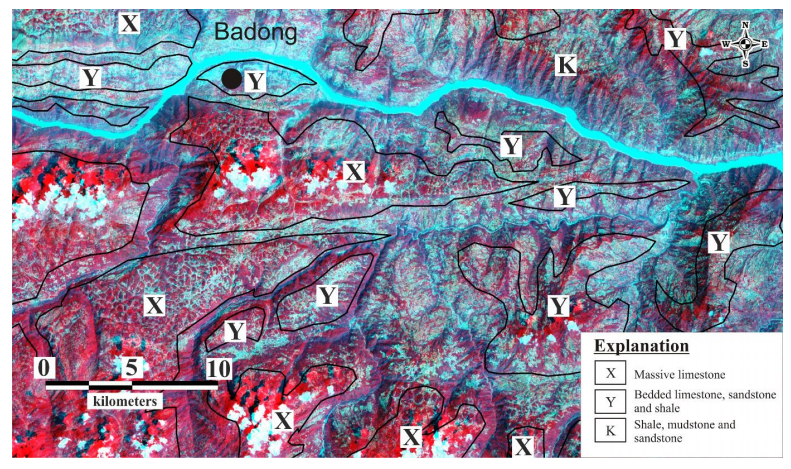 Figure 5. ASTER 321 false color composite view of the study area (The ASTER image was acquired in 25th of September, 2002).
Figure 5. ASTER 321 false color composite view of the study area (The ASTER image was acquired in 25th of September, 2002).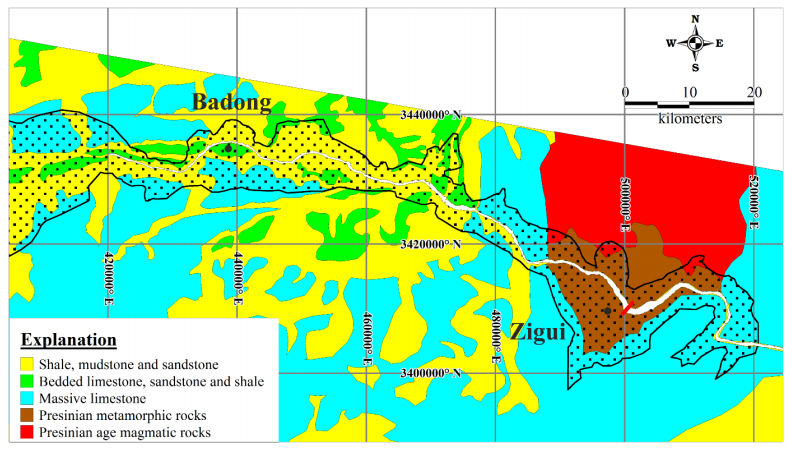 Figure 6. Geological map of the Three Gorges Project area extracted from Landsat TM/ETM+ and ASTER images.
Figure 6. Geological map of the Three Gorges Project area extracted from Landsat TM/ETM+ and ASTER images.ASTER GDEM (Version 1) was used in this study to prepare the maps of slope angle, slope aspect, drainage, and lineament.
Independent research was conducted using GPS survey benchmarks to assess the absolute vertical accuracy of ASTER GDEM in different geographical regions over China [55]. In the TG region, the coordinates of 121 GPS survey stations were obtained with centimetre level accuracy (Figure 7.a), and then a correlation analysis between GPS and ASTER GDEM was performed. A correlation of 0.97, a mean difference of-5.9 metres and a RMS value of 12.1 metres were observed [56] (Figure 7.b).
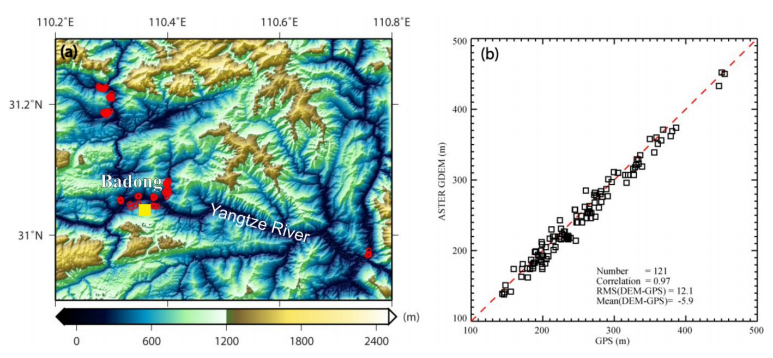 Figure 7. (a) Shaded relief map of the study area in Three Gorges with the locations of Static GPS points plotted on the ASTER GDEM. Red circles represent GCPs. (b) Scatterplot of ASTER GDEM and Static GPS heights in Three Gorges. The dashed line represents the line of perfect fit [55].
Figure 7. (a) Shaded relief map of the study area in Three Gorges with the locations of Static GPS points plotted on the ASTER GDEM. Red circles represent GCPs. (b) Scatterplot of ASTER GDEM and Static GPS heights in Three Gorges. The dashed line represents the line of perfect fit [55].Methods can be divided into six stages: (ⅰ) determination of variables relevant to landslide susceptibility; (ⅱ) preparation of thematic maps using variables, (ⅲ) extraction of spatial information to generate a Vector Grid File (VGF) having 30 x 30 metres resolution, (ⅳ) preparation of a LSM using the VGF and (ⅴ) preparation of a thematic deformation map using Persistent Scatterer (PS) InSAR techniques and (ⅵ) a comparison of (ⅳ) and (ⅴ) (Figure 8).
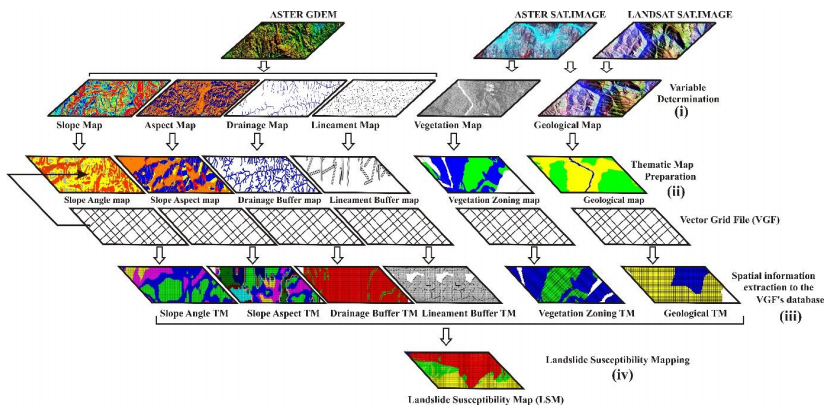 Figure 8. The processing of the data-sets used to obtain LSM. Flow chart of the study ((ⅰ) determination of variables relevant to landslide susceptibility; (ⅱ) preparation of thematic maps using variables, (ⅲ) extraction of spatial information to generate a Vector Grid File (VGF) having 30 × 30 metres resolution, (ⅳ) preparation of a LSM using the VGF and (ⅴ) preparation of a thematic deformation map using Persistent Scatterer (PS) InSAR techniques).
Figure 8. The processing of the data-sets used to obtain LSM. Flow chart of the study ((ⅰ) determination of variables relevant to landslide susceptibility; (ⅱ) preparation of thematic maps using variables, (ⅲ) extraction of spatial information to generate a Vector Grid File (VGF) having 30 × 30 metres resolution, (ⅳ) preparation of a LSM using the VGF and (ⅴ) preparation of a thematic deformation map using Persistent Scatterer (PS) InSAR techniques).After visual interpretation of Landsat and ASTER images to extract geological outcrop boundaries in the study area, these outcrops were regrouped based on lithological attributes rather than their stratigraphic content and age [18,30]. Many researchers involve lithology as a factor in susceptibility mapping [57,58,59,60,61,62,63]. Vector Grid File (VGF) based GIS model was created to determine the LSM for the Three Gorges, Yangtze River (China) site. Then, this LS map is validated with InSAR results.
Researchers working on soils obtained from different landslide sites in TG area have found that the average internal friction angle for saturated soils is 10 degrees [64]. A slope angle map was thus categorized in classes 0–10°, 11–20°, 21–30°, 31–40° and > 40° as having low (for 0–10°), moderate (for 11–20° and 21–30°) and high landslide susceptibility (for 31–40° and > 40°) (Table 3, Figure 9).
| Variable | Data Source | Techniques used | Data Type |
| Geology | Landsat and ASTER images | Visual interpretation | Polygon |
| Slope angle | ASTER GDEM | Contouring | Polygon |
| Slope Aspect | ASTER GDEM | Contouring | Polygon |
| Lineament | Ortorectified Landsat & ASTER images | Screen digitising | Polyline |
| Drainage | ASTER GDEM | Screen digitising | Polyline |
| Vegetation | Landsat | NDVI | Polygon |
| NDVI: Normalized Difference Vegetation Index | |||
| Geology/lithology Category |
Lithology Points |
Slope Aspect Category |
Slope Aspect Points |
| Sandstone-shale-claystone intercalations | 30 | 0-45° | 20 |
| Bedded limestone and sandtone | 10 | 45-90° | 10 |
| Massive limestone | 10 | 90-135° | 10 |
| Presinian metamorphic rock | 10 | 135-180° | 20 |
| Presinian magmatic rock | 10 | 180-225° | 20 |
| Vegetation Category |
Vegetation Points |
225-270° | 10 |
| No | 10 | 270-315° | 10 |
| Intermediate | 10 | 315-360° | 20 |
| Dense | 0 | ||
| Lineament Category |
Lineament Points |
Drainage Category |
Drainage Points |
| In 50 m buffer | 5 | In 50 m buffer | 5 |
| In 50-100 m buffer | 10 | In 50-100 m buffer | 10 |
| In 100-200 m buffer | 15 | In 100-200 m buffer | 15 |
| Slope Angle Category | Slope Angle Points |
||
| 0-10° | 10 | ||
| 11-20° | 20 | ||
| 21-30° | 20 | ||
| 31-40° | 30 | ||
| > 40° | 30 | ||
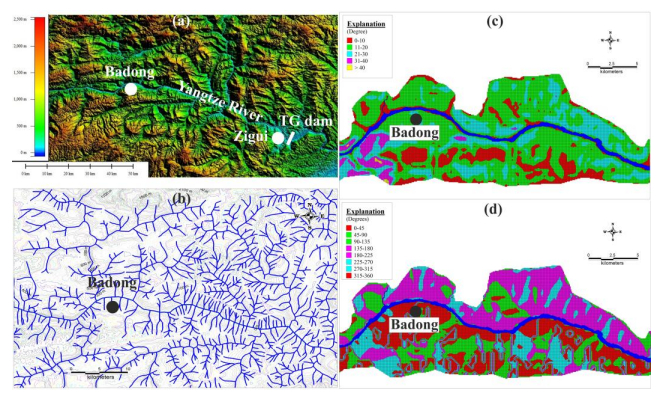 Figure 9. (a) ASTER GDEM of the study area, (b) Vector drainage network of the study area (c) Slope angle map of the Badong County, (d) Aspect map of the Badong County.
Figure 9. (a) ASTER GDEM of the study area, (b) Vector drainage network of the study area (c) Slope angle map of the Badong County, (d) Aspect map of the Badong County.An aspect hazard map was prepared according to whether the aspect of the slope inclined towards the Yangtze River. This aspect map was classified into 8 classes according to aspect directions of 0–45°, 45–90°, 90–135°, 135–180°, 180–225°, 225–270°, 270–315° and 315–360°. For the southern slopes of the Yangtze River, an aspect zone of 315–45° was chosen and for the northern slopes of the Yangtze River, an aspect zone of 135–225° was chosen as the critical aspect zones for landslides (Figure 8 and 9).
Lineaments were digitised as geological structures. The distance to the lineament map (lineament buffer map) signifies the presence of joint-fractures affecting shear strength [18,30]. Buffer zones were created for distances of 0–50, 50–100 and 100–200 metres for each lineament feature (Figure 8).
The drainage network was digitized from generated contours using ASTER G-DEM data [65]. After digitising, buffer zones were created at 0–50, 50–100 and 100–200 metres for each drainage channel (Figure 9b). Also, water level in 2006 digitized from a Landsat image, was considered during the drainage buffer analysis, as later described.
A vegetation map was prepared using the Normalized Difference Vegetation Index (NDVI) calculation in the range between-1 and 1. Forest, agricultural fields, barren land, water and wet areas are the main land cover classes determined from this image. The NDVI map was classified as water (-1.00 to-0.01), wet areas (0.00 to 0.32), barren land (0.33 to 0.63), intermediate vegetation (0.64 to 0.76) and dense vegetation (0.77 to 1.00). A high susceptibility score was given to barren land and a low score to forested land.
In an approach developed by [66], spatial information for all map layers saved in a database related to landslide potential was produced. An overlay technique was used to combine data from a number of maps in order to prepare a new map that is termed a "VGF-based LSM". For the preparation of the susceptibility map, raster background images (e.g. geological maps derived from satellite imagery) were digitized to form geology layers. Then, all digital thematic maps (geology, slope angle, slope aspect, drainage, lineament, vegetation) were converted to vector pixels from a dataset of all digital maps [66]. GIS enables end users to carry out a complete land-use planning and seismic-risk assessment at regional, sub-regional and local scales [67]. All analyses for the present study were carried out at a sub-regional scale.
A Vector Grid File (VGF), containing 132.692 vector areas (or "vector pixels") of size 30 × 30 m was created using the "Grid Maker" command (of MapInfo Professional) to cover the Badong County (see Figure 10). Then, columns were inserted into the VGF file's attribute database – one for each digital raster map. Next, each digital thematic map was overlaid on the new blank VGF.
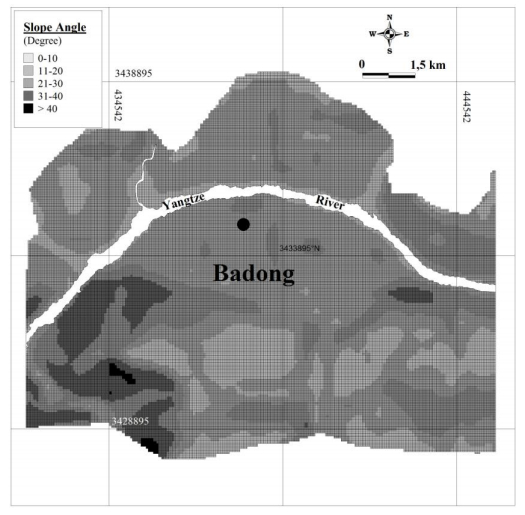 Figure 10. Thematic map prepared using the VGF file for slope angle.
Figure 10. Thematic map prepared using the VGF file for slope angle.A susceptibility score was assigned to the database for each map pixel as suggested by [24] and [68] (Table 3). Then the VGF susceptibility score was calculated according to Equation (1)
| LandslideSusceptibility=∑Pointsof[San+Sas+Lit+Lin+Dra+Veg] | (1) |
where;
San: Slope Angle, Sas: Slope Aspect, Lit: Lithology, Lin: Lineament, Dra: Drainage, Veg: Vegetation.
A LSM was prepared using the total number of VGF susceptibility points (scores) (Figure 11). The LSM has been obtained by reclassifying the values obtained by means of Eq. (1) into three categories: High, Medium and Low.
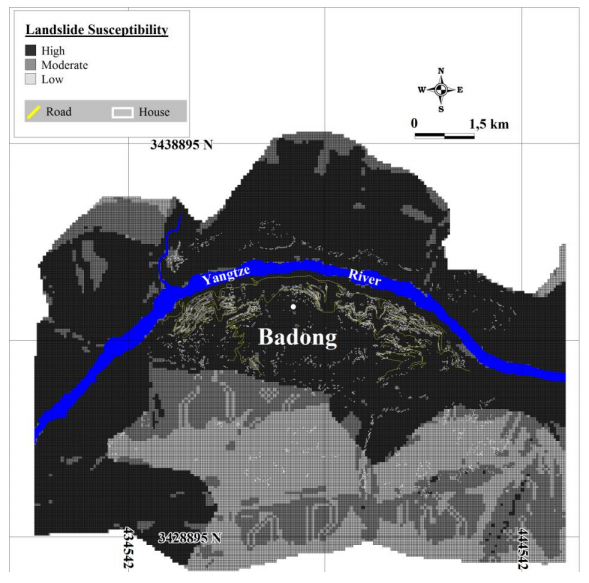 Figure 11. Landslide susceptibility map of the Badong County in the Three Gorges Region.
Figure 11. Landslide susceptibility map of the Badong County in the Three Gorges Region.A deformation map was then created using PS InSAR results. The prepared LSM and the PS InSAR deformation results are compared in Section 6.
LSMs are a special type of engineering geological maps, and present all the components of the geological and geo-morphological environment. Such maps should be based on the combination of all relevant – mainly engineering geological – parameters. This combination can be realized by using an overlay process in the GIS environment, which is perhaps one of the key functions of a GIS; it allows for construction of a new integrating layer [69]. One can distinguish three major categories of approaches to GIS-based land-use suitability analysis in the literature: (1) computer-assisted overlay mapping, (2) multi-criteria evaluation methods, and (3) soft computing or geo-computation methods [70]. Overlay with a weighting technique was used during the landslide susceptibility analysis. Point scores were assigned according to sliding susceptibilities as defined in Table 3 and 4. If the unit cell in the VGF is more susceptible to sliding, then a high point (score) is given, otherwise a low one is assigned [71,72]. Categories (1) and (2) are performed in this study as other scientists did. But, different point scores to the areas which have different type of susceptibility class are given in this study and VGF-based technique is a novel in this case study area. For this purpose, the existing landslide inventory map of the study area was used in order to perform a zonation of land units similarly prone to generate landslides or in order to quantitatively validate the obtained susceptibility map.
There is no doubt that landslides will be seen along the slopes of the Yangtze River. Slope angle and slope aspect maps were prepared to determine landslide susceptibility analysis zones (Figure 10). As already stated, the vector grid file (VGF) is made up of 132, 697 cells (Figure 10) with the dimension of each cell being 30 × 30 m (Table 3 and 4).
Point scores (weighting factors) were given to the "slope angle" categories according to their landslide susceptibilities as follows: ten points for 0-10°; twenty points for 11–30°; and, thirty points for > 31°, respectively.
Point scores (weighting factors) were given to the "slope aspect" categories according to their landslide susceptibilities with ten points for 45–90°, 90–135° and 225–270°, and twenty points for 0–45°, 135–180° and 180–225° slopes, respectively (Tables 3 and 4).
Point scores (weighting factors) were given to the "lithology" categories according to their landslide susceptibilities with ten points for bedded limestone, massive limestone and Presinian metamorphic and magmatic rocks, and thirty points for sandstone-shale-claystone intercalations.
Point scores (weighting factors) were given to the "lineament" and "drainage" categories according to their landslide susceptibilities as five, ten and fifteen for 0–50, 50–100 and 100–200 metres distance from the river bed, respectively.
Point scores (weighting factors) were given to the "vegetation" categories according to their landslide susceptibilities as ten points for the barren field, ten points for the less vegetation zones and zero-point for dense vegetation zones (Table 3).
Finally, all susceptibility point scores in the six columns were summed and a column named "Total" created in the database (Equation 1). The LSM was created as a thematic map based on the total value of these point scores after applying the relevant weighting factors.
76 ≤ Landslide Susceptibility = > High landslide susceptibility zone
36 ≤ Landslide Susceptibility < 76 = > Moderate landslide susceptibility zone
Landslide Susceptibility < 36 = > Low landslide susceptibility zone
Classes were divided into three categories with the help of the landslide inventory map and statistical natural breaks of the total point range data (Figure 11).
The susceptibility of each 'vector pixel' to landslides is displayed in Figure 11 with an explanation of low to high landslide susceptibility. Areas of high susceptibility are categorised by steep slope gradients with a 'soft' sandstone-shale-claystone intercalations lithology. Smaller features with high susceptibility values observed in the map generally correspond to lineaments and/or drainage network. A LSM is considered to be categorised if it shows three susceptibility zones: (a) high, (b) moderate and (c) low landslide potential zones (Figure 11).
Interferometric SAR (InSAR) has been used to map surface displacements of the Earth's surface by calculating the phase differences in complex representations (magnitude and phase). Synthetic Aperture Radar (SAR) images are acquired under similar geometric conditions but at different acquisition dates [73]. The sources of error for conventional InSAR principally include atmospheric water vapour effects and temporal decorrelation [74]. Several approaches have been developed to address these two issues. Ferretti et al. proposed Permanent Scatterers InSAR improved by Colesanti et al. and by Kampes [75,76,77,78]. In these methods, the amplitude information of a group of PS candidates are analysed using a series of interferograms. These methods work well in urban areas where corner-like reflecting objects appear bright in SAR images. But these methods do not turn out very well in natural terrain because of the absence of man-made structures [56]. The second approach identifies PS pixels primarily on phase characteristics as demonstrated by Hooper et al. [79,80]. This method can find low-amplitude but stable pixels that cannot normally be identified using only amplitude data.
Persistent Scatterer (PS) InSAR supports users with reliable deformation measurements by identifying single coherent pixels using a long temporal series of interferograms and estimating atmospheric signals [76].
In this study, the StaMPS package was used to process 13 ENVISAT images from descending track 075 collected between November 2003 and March 2008 [79]. The comparison between two adjacent tracks shows the PS derived deformation map is reliable with a RMS of 0.41 mm [56].
To evaluate the GIS-model, PS-InSAR derived deformation signals were overlaid on the susceptibility map. In Figure 10, grey points represent stable pixels, purple points indicate subsidence pixels and blue points imply uplift pixels. It should be noted that the density of PS-InSAR points does not show the magnitude of deformation; substantial clusters of PS-InSAR points merely correspond to more populated areas (e.g. houses indicated in white in Figure 12) which possibly exhibit high radar backscatter values from man-made buildings. A simple spatial analysis of Ikonos imagery reveals that 13.5 % of PS points are located on tops of buildings.
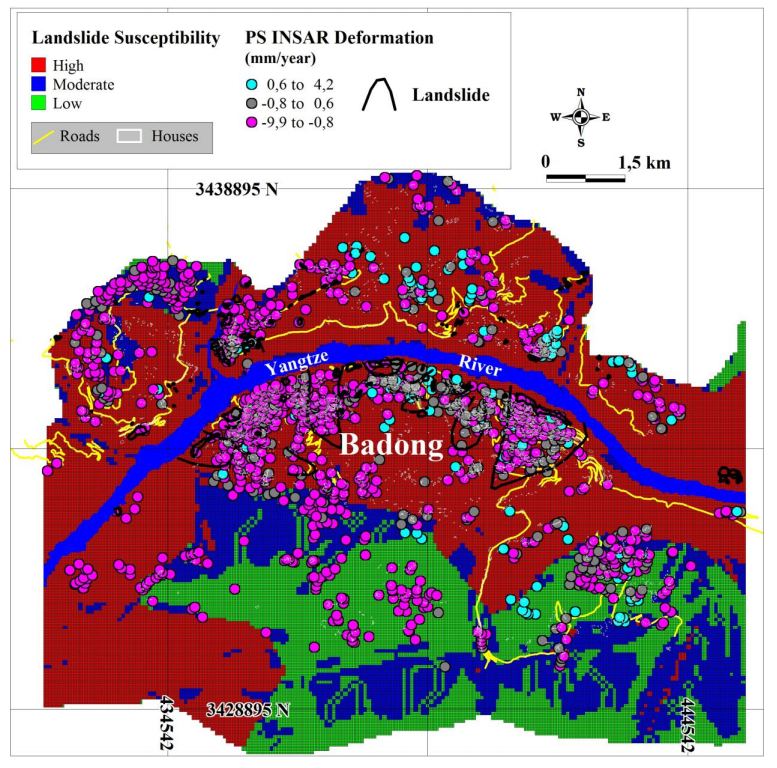 Figure 12. Landslide Susceptibility Map overlaid with PS InSAR derived deformation signals (Locations of the large landslides were extracted from [44]).
Figure 12. Landslide Susceptibility Map overlaid with PS InSAR derived deformation signals (Locations of the large landslides were extracted from [44]).Although PS points are limited to points with good coherence from a long series of interferograms, there is a good correspondence of points with the GIS-based susceptibility model. It is clear in Tables 5 that 84.8% of the subsidence deformation points are located in areas classified by the GIS-model as moderately and highly susceptible to landslides.
| |
High | Moderate | Low | Total |
| 0.6 to 4.2 (uplift) | 85 (6.8%) | 7 (0.6%) | 17 (1.3%) | 109 (8.7%) |
| -0.8 to 0.6 (stable) | 187 (14.8%) | 40 (3.2%) | 38 (3.0%) | 265 (21.0%) |
| -9.9 to-0.8 (subsidence) | 615 (48.7%) | 138 (10.9%) | 135 (10.7%) | 888 (70.3%) |
| Total | 887 (70.3%) | 185 (14.7%) | 190 (15.0%) | 1262 (100.0%) |
In this case study, a LSM generated for the Badong County, TG of China, using information layers derived from satellite optical images (specifically ASTER and Landsat) and ASTER GDEM, which agrees well with our PS InSAR derived deformation maps. Both suggest that 59.8% of the study area is classified as "Highly susceptible to landslides", and 19.4% of this is classified as "moderately susceptible to landslides" (Figure 12). 84.8% of the subsidence PS-InSAR points were calculated in moderately and highly susceptible landslide zone. Landslides which have occurred do indeed show in the "High landslide susceptibility zone" of the LSM prepared in this case study (Figure 13) [44].
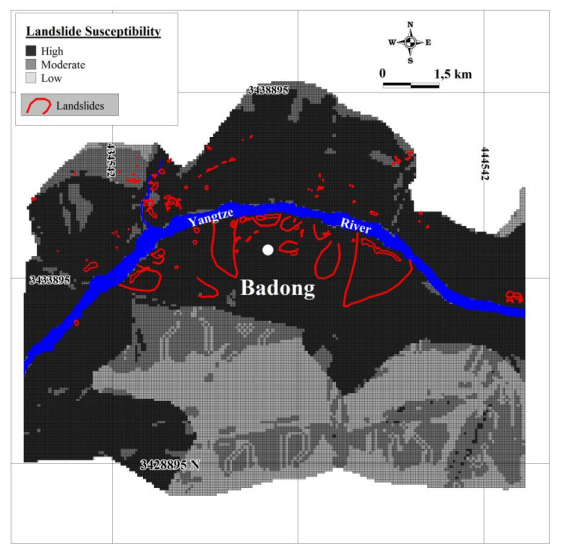 Figure 13. Landslides which were occurred previously as observed in the "High Landslide Susceptibility Zone" (Locations of the large landslides were taken from [44]).
Figure 13. Landslides which were occurred previously as observed in the "High Landslide Susceptibility Zone" (Locations of the large landslides were taken from [44]).A VGF was created to calculate a GIS-based analysis with 30 meters accuracy. For local scales, this resolution can be increased depending on the scales of the digital thematic maps prepared.
As a result, the investigated case study site of Badong County can be considered an active landslide area with the help of PS InSAR data and field observations. Landslides can be re-activated by the land-use changes which are now happening in Badong County. New landslides may occur in the area classified as "high landslide susceptible zone" in the LSM if preventive measures are not met against the triggering effect of reactivated fossil landslides. Mass movements, other than landslides, such as planar, wedge and toppling forms should also be analyzed in the future, after obtaining relevant detailed field data.
This work can be used in landslide susceptibility mapping studies if a vector-based database is available. Also, the weighting of each digital thematic layer on landslide susceptibility is scored in this case study. Authors who have score points for different geo-referenced areas could use this work in their studies. Vector-pixel based landslide susceptibility analyses has more advantages then raster-pixel based one. We suggest geoscientists to use this work in their scientific studies to obtain fast and reliable results during their landslide susceptibility analysis.
This work is supported by The Scientific and Technological Research Council of Turkey fellowship to CK and a CSC scholarship to PL. Part of this work is also supported by the Natural Environmental Research Council (NERC) through the GAS project (Ref: NE/H001085/1) as well as by a China 863 Project (ID: 2009AA12Z317). The ENVISAT images were supplied through the ESA-MOST Dragon 2 Cooperation Program (ID: 5343, PI: J-P Muller).
All authors declare no conflicts of interest in this paper.
| [1] | Berx G, van Roy F (2009) Involvement of members of the cadherin superfamily in cancer. Cold Spring Harb Perspect Biol 1: a003129. |
| [2] |
Ranscht B, Dours-Zimmermann MT (1991) T-cadherin, a novel cadherin cell adhesion molecule in the nervous system lacks the conserved cytoplasmic region. Neuron 7: 391-402. doi: 10.1016/0896-6273(91)90291-7

|
| [3] |
Pfaff D, Philippova M, Kyriakakis E, et al. (2011) Paradoxical effects of T-cadherin on squamous cell carcinoma: up- and down-regulation increase xenograft growth by distinct mechanisms. J Pathol 225: 512-524. doi: 10.1002/path.2900

|
| [4] | Fredette BJ, Ranscht B (1994) T-cadherin expression delineates specific regions of the developing motor axon-hindlimb projection pathway. J Neurosci 14: 7331-7346. |
| [5] |
Philippova M, Joshi MB, Kyriakakis E, et al. (2009) A guide and guard: the many faces of T-cadherin. Cell Signal 21: 1035-1044. doi: 10.1016/j.cellsig.2009.01.035

|
| [6] |
Rubina KA, Surkova EI, Semina EV, et al. (2015) T-Cadherin Expression in Melanoma Cells Stimulates Stromal Cell Recruitment and Invasion by Regulating the Expression of Chemokines, Integrins and Adhesion Molecules. Cancers (Basel) 7: 1349-1370. doi: 10.3390/cancers7030840

|
| [7] | Wyder L, Vitaliti A, Schneider H, et al. (2000) Increased expression of H/T-cadherin in tumor-penetrating blood vessels. Cancer Res 60: 4682-4688. |
| [8] |
Dames SA, Bang E, Haussinger D, et al. (2008) Insights into the low adhesive capacity of human T-cadherin from the NMR structure of Its N-terminal extracellular domain. J Biol Chem 283: 23485-23495. doi: 10.1074/jbc.M708335200

|
| [9] |
Teng MS, Hsu LA, Wu S, et al. (2015) Association of CDH13 genotypes/haplotypes with circulating adiponectin levels, metabolic syndrome, and related metabolic phenotypes: the role of the suppression effect. PLoS One 10: e0122664. doi: 10.1371/journal.pone.0122664

|
| [10] |
Org E, Eyheramendy S, Juhanson P, et al. (2009) Genome-wide scan identifies CDH13 as a novel susceptibility locus contributing to blood pressure determination in two European populations. Hum Mol Genet 18: 2288-2296. doi: 10.1093/hmg/ddp135

|
| [11] | Angst BD, Marcozzi C, Magee AI (2001) The cadherin superfamily: diversity in form and function. J Cell Sci 114: 629-641. |
| [12] |
Sato M, Mori Y, Sakurada A, et al. (1998) The H-cadherin (CDH13) gene is inactivated in human lung cancer. Hum Genet 103: 96-101. doi: 10.1007/s004390050790

|
| [13] | Behrens J, Lowrick O, Klein-Hitpass L, et al. (1991) The E-cadherin promoter: functional analysis of a G.C-rich region and an epithelial cell-specific palindromic regulatory element. Proc Natl Acad Sci U S A 88: 11495-11499. |
| [14] | Jarrard DF, Paul R, van Bokhoven A, et al. (1997) P-Cadherin is a basal cell-specific epithelial marker that is not expressed in prostate cancer. Clin Cancer Res 3: 2121-2128. |
| [15] |
Bromhead C, Miller JH, McDonald FJ (2006) Regulation of T-cadherin by hormones, glucocorticoid and EGF. Gene 374: 58-67. doi: 10.1016/j.gene.2006.01.013

|
| [16] |
Niermann T, Schmutz S, Erne P, et al. (2003) Aryl hydrocarbon receptor ligands repress T-cadherin expression in vascular smooth muscle cells. Biochem Biophys Res Commun 300: 943-949. doi: 10.1016/S0006-291X(02)02970-4

|
| [17] |
Ellmann L, Joshi MB, Resink TJ, et al. (2012) BRN2 is a transcriptional repressor of CDH13 (T-cadherin) in melanoma cells. Lab Invest 92: 1788-1800. doi: 10.1038/labinvest.2012.140

|
| [18] |
Kuzmenko YS, Stambolsky D, Kern F, et al. (1998) Characteristics of smooth muscle cell lipoprotein binding proteins (p105/p130) as T-cadherin and regulation by positive and negative growth regulators. Biochem Biophys Res Commun 246: 489-494. doi: 10.1006/bbrc.1998.8645

|
| [19] |
Ciatto C, Bahna F, Zampieri N, et al. (2010) T-cadherin structures reveal a novel adhesive binding mechanism. Nat Struct Mol Biol 17: 339-347. doi: 10.1038/nsmb.1781

|
| [20] |
Vestal DJ, Ranscht B (1992) Glycosyl phosphatidylinositol--anchored T-cadherin mediates calcium-dependent, homophilic cell adhesion. J Cell Biol 119: 451-461. doi: 10.1083/jcb.119.2.451

|
| [21] |
Sacristan MP, Vestal DJ, Dours-Zimmermann MT, et al. (1993) T-cadherin 2: molecular characterization, function in cell adhesion, and coexpression with T-cadherin and N-cadherin. J Neurosci Res 34: 664-680. doi: 10.1002/jnr.490340610

|
| [22] |
Harrison OJ, Bahna F, Katsamba PS, et al. (2010) Two-step adhesive binding by classical cadherins. Nat Struct Mol Biol 17: 348-357. doi: 10.1038/nsmb.1784

|
| [23] |
Winterhalter PR, Lommel M, Ruppert T, et al. (2013) O-glycosylation of the non-canonical T-cadherin from rabbit skeletal muscle by single mannose residues. FEBS Lett 587: 3715-3721. doi: 10.1016/j.febslet.2013.09.041

|
| [24] |
Stambolsky DV, Kuzmenko YS, Philippova MP, et al. (1999) Identification of 130 kDa cell surface LDL-binding protein from smooth muscle cells as a partially processed T-cadherin precursor. Biochim Biophys Acta 1416: 155-160. doi: 10.1016/S0005-2736(98)00218-1

|
| [25] |
Mavroconstanti T, Johansson S, Winge I, et al. (2013) Functional properties of rare missense variants of human CDH13 found in adult attention deficit/hyperactivity disorder (ADHD) patients. PLoS One 8: e71445. doi: 10.1371/journal.pone.0071445

|
| [26] |
Wang Y, Lam KS, Yau MH, et al. (2008) Post-translational modifications of adiponectin: mechanisms and functional implications. Biochem J 409: 623-633. doi: 10.1042/BJ20071492

|
| [27] |
Fruebis J, Tsao TS, Javorschi S, et al. (2001) Proteolytic cleavage product of 30-kDa adipocyte complement-related protein increases fatty acid oxidation in muscle and causes weight loss in mice. Proc Natl Acad Sci U S A 98: 2005-2010. doi: 10.1073/pnas.98.4.2005

|
| [28] |
Pajvani UB, Hawkins M, Combs TP, et al. (2004) Complex distribution, not absolute amount of adiponectin, correlates with thiazolidinedione-mediated improvement in insulin sensitivity. J Biol Chem 279: 12152-12162. doi: 10.1074/jbc.M311113200

|
| [29] |
Scherer PE, Williams S, Fogliano M, et al. (1995) A novel serum protein similar to C1q, produced exclusively in adipocytes. J Biol Chem 270: 26746-26749. doi: 10.1074/jbc.270.45.26746

|
| [30] |
Yamauchi T, Kamon J, Ito Y, et al. (2003) Cloning of adiponectin receptors that mediate antidiabetic metabolic effects. Nature 423: 762-769. doi: 10.1038/nature01705

|
| [31] |
Yamauchi T, Kadowaki T (2013) Adiponectin receptor as a key player in healthy longevity and obesity-related diseases. Cell Metab 17: 185-196. doi: 10.1016/j.cmet.2013.01.001

|
| [32] |
Hebbard L, Ranscht B (2014) Multifaceted roles of adiponectin in cancer. Best Pract Res Clin Endocrinol Metab 28: 59-69. doi: 10.1016/j.beem.2013.11.005

|
| [33] |
Hug C, Wang J, Ahmad NS, et al. (2004) T-cadherin is a receptor for hexameric and high-molecular-weight forms of Acrp30/adiponectin. Proc Natl Acad Sci U S A 101: 10308-10313. doi: 10.1073/pnas.0403382101

|
| [34] |
Hebbard LW, Garlatti M, Young LJ, et al. (2008) T-cadherin supports angiogenesis and adiponectin association with the vasculature in a mouse mammary tumor model. Cancer Res 68: 1407-1416. doi: 10.1158/0008-5472.CAN-07-2953

|
| [35] |
Denzel MS, Scimia MC, Zumstein PM, et al. (2010) T-cadherin is critical for adiponectin-mediated cardioprotection in mice. J Clin Invest 120: 4342-4352. doi: 10.1172/JCI43464

|
| [36] |
Parker-Duffen JL, Nakamura K, Silver M, et al. (2013) T-cadherin is essential for adiponectin-mediated revascularization. J Biol Chem 288: 24886-24897. doi: 10.1074/jbc.M113.454835

|
| [37] |
Rivero O, Sich S, Popp S, et al. (2013) Impact of the ADHD-susceptibility gene CDH13 on development and function of brain networks. Eur Neuropsychopharmacol 23: 492-507. doi: 10.1016/j.euroneuro.2012.06.009

|
| [38] | Fredette BJ, Miller J, Ranscht B (1996) Inhibition of motor axon growth by T-cadherin substrata. Development 122: 3163-3171. |
| [39] |
Hayano Y, Zhao H, Kobayashi H, et al. (2014) The role of T-cadherin in axonal pathway formation in neocortical circuits. Development 141: 4784-4793. doi: 10.1242/dev.108290

|
| [40] |
Treutlein J, Cichon S, Ridinger M, et al. (2009) Genome-wide association study of alcohol dependence. Arch Gen Psychiatry 66: 773-784. doi: 10.1001/archgenpsychiatry.2009.83

|
| [41] |
Johnson C, Drgon T, Liu QR, et al. (2006) Pooled association genome scanning for alcohol dependence using 104,268 SNPs: validation and use to identify alcoholism vulnerability loci in unrelated individuals from the collaborative study on the genetics of alcoholism. Am J Med Genet B Neuropsychiatr Genet 141B: 844-853. doi: 10.1002/ajmg.b.30346

|
| [42] |
Arias-Vasquez A, Altink ME, Rommelse NN, et al. (2011) CDH13 is associated with working memory performance in attention deficit/hyperactivity disorder. Genes Brain Behav 10: 844-851. doi: 10.1111/j.1601-183X.2011.00724.x

|
| [43] |
Rivero O, Selten MM, Sich S, et al. (2015) Cadherin-13, a risk gene for ADHD and comorbid disorders, impacts GABAergic function in hippocampus and cognition. Transl Psychiatry 5: e655. doi: 10.1038/tp.2015.152

|
| [44] | Drgonova J, Walther D, Hartstein GL, et al. (2016) Cadherin 13: human cis-regulation and selectively-altered addiction phenotypes and cerebral cortical dopamine in knockout mice. Mol Med 22. |
| [45] | Shen LH, Liao MH, Tseng YC (2012) Recent advances in imaging of dopaminergic neurons for evaluation of neuropsychiatric disorders. J Biomed Biotechnol 2012: 259349. |
| [46] |
Poliak S, Norovich AL, Yamagata M, et al. (2016) Muscle-type Identity of Proprioceptors Specified by Spatially Restricted Signals from Limb Mesenchyme. Cell 164: 512-525. doi: 10.1016/j.cell.2015.12.049

|
| [47] |
Huang ZY, Wu Y, Hedrick N, et al. (2003) T-cadherin-mediated cell growth regulation involves G2 phase arrest and requires p21(CIP1/WAF1) expression. Mol Cell Biol 23: 566-578. doi: 10.1128/MCB.23.2.566-578.2003

|
| [48] |
Matsuda K, Fujishima Y, Maeda N, et al. (2015) Positive feedback regulation between adiponectin and T-cadherin impacts adiponectin levels in tissue and plasma of male mice. Endocrinology 156: 934-946. doi: 10.1210/en.2014-1618

|
| [49] |
Niermann T, Kern F, Erne P, et al. (2000) The glycosyl phosphatidylinositol anchor of human T-cadherin binds lipoproteins. Biochem Biophys Res Commun 276: 1240-1247. doi: 10.1006/bbrc.2000.3465

|
| [50] | Joshi MB, Philippova M, Ivanov D, et al. (2005) T-cadherin protects endothelial cells from oxidative stress-induced apoptosis. FASEB J 19: 1737-1739. |
| [51] |
Joshi MB, Ivanov D, Philippova M, et al. (2007) Integrin-linked kinase is an essential mediator for T-cadherin-dependent signaling via Akt and GSK3beta in endothelial cells. FASEB J 21: 3083-3095. doi: 10.1096/fj.06-7723com

|
| [52] |
Philippova M, Ivanov D, Joshi MB, et al. (2008) Identification of proteins associating with glycosylphosphatidylinositol- anchored T-cadherin on the surface of vascular endothelial cells: role for Grp78/BiP in T-cadherin-dependent cell survival. Mol Cell Biol 28: 4004-4017. doi: 10.1128/MCB.00157-08

|
| [53] |
Kyriakakis E, Philippova M, Joshi MB, et al. (2010) T-cadherin attenuates the PERK branch of the unfolded protein response and protects vascular endothelial cells from endoplasmic reticulum stress-induced apoptosis. Cell Signal 22: 1308-1316. doi: 10.1016/j.cellsig.2010.04.008

|
| [54] |
Resink TJ, Kuzmenko YS, Kern F, et al. (1999) LDL binds to surface-expressed human T-cadherin in transfected HEK293 cells and influences homophilic adhesive interactions. FEBS Lett 463: 29-34. doi: 10.1016/S0014-5793(99)01594-X

|
| [55] |
Rubina K, Talovskaya E, Cherenkov V, et al. (2005) LDL induces intracellular signalling and cell migration via atypical LDL-binding protein T-cadherin. Mol Cell Biochem 273: 33-41. doi: 10.1007/s11010-005-0250-5

|
| [56] |
Kipmen-Korgun D, Osibow K, Zoratti C, et al. (2005) T-cadherin mediates low-density lipoprotein-initiated cell proliferation via the Ca(2+)-tyrosine kinase-Erk1/2 pathway. J Cardiovasc Pharmacol 45: 418-430. doi: 10.1097/01.fjc.0000157458.91433.86

|
| [57] |
Ivanov D, Philippova M, Tkachuk V, et al. (2004) Cell adhesion molecule T-cadherin regulates vascular cell adhesion, phenotype and motility. Exp Cell Res 293: 207-218. doi: 10.1016/j.yexcr.2003.09.030

|
| [58] |
Ivanov D, Philippova M, Allenspach R, et al. (2004) T-cadherin upregulation correlates with cell-cycle progression and promotes proliferation of vascular cells. Cardiovasc Res 64: 132-143. doi: 10.1016/j.cardiores.2004.06.010

|
| [59] |
Philippova M, Banfi A, Ivanov D, et al. (2006) Atypical GPI-anchored T-cadherin stimulates angiogenesis in vitro and in vivo. Arterioscler Thromb Vasc Biol 26: 2222-2230. doi: 10.1161/01.ATV.0000238356.20565.92

|
| [60] |
Frismantiene A, Pfaff D, Frachet A, et al. (2014) Regulation of contractile signaling and matrix remodeling by T-cadherin in vascular smooth muscle cells: constitutive and insulin-dependent effects. Cell Signal 26: 1897-1908. doi: 10.1016/j.cellsig.2014.05.001

|
| [61] |
Kostopoulos CG, Spiroglou SG, Varakis JN, et al. (2014) Adiponectin/T-cadherin and apelin/APJ expression in human arteries and periadventitial fat: implication of local adipokine signaling in atherosclerosis? Cardiovasc Pathol 23: 131-138. doi: 10.1016/j.carpath.2014.02.003

|
| [62] | Fujishima Y, Maeda N, Matsuda K, et al. (2017) Adiponectin association with T-cadherin protects against neointima proliferation and atherosclerosis. FASEB J. |
| [63] |
Philippova M, Suter Y, Toggweiler S, et al. (2011) T-cadherin is present on endothelial microparticles and is elevated in plasma in early atherosclerosis. Eur Heart J 32: 760-771. doi: 10.1093/eurheartj/ehq206

|
| [64] |
Tyrberg B, Miles P, Azizian KT, et al. (2011) T-cadherin (Cdh13) in association with pancreatic beta-cell granules contributes to second phase insulin secretion. Islets 3: 327-337. doi: 10.4161/isl.3.6.17705

|
| [65] | Andreeva AV, Kutuzov MA (2010) Cadherin 13 in cancer. Genes Chromosomes Cancer 49: 775-790. |
| [66] |
Kong DD, Yang J, Li L, et al. (2015) T-cadherin association with clinicopathological features and prognosis in axillary lymph node-positive breast cancer. Breast Cancer Res Treat 150: 119-126. doi: 10.1007/s10549-015-3302-x

|
| [67] |
Lee SW (1996) H-cadherin, a novel cadherin with growth inhibitory functions and diminished expression in human breast cancer. Nat Med 2: 776-782. doi: 10.1038/nm0796-776

|
| [68] | Toyooka KO, Toyooka S, Virmani AK, et al. (2001) Loss of expression and aberrant methylation of the CDH13 (H-cadherin) gene in breast and lung carcinomas. Cancer Res 61: 4556-4560. |
| [69] |
Miki Y, Katagiri T, Nakamura Y (1997) Infrequent mutation of the H-cadherin gene on chromosome 16q24 in human breast cancers. Jpn J Cancer Res 88: 701-704. doi: 10.1111/j.1349-7006.1997.tb00439.x

|
| [70] |
Celebiler Cavusoglu A, Kilic Y, Saydam S, et al. (2009) Predicting invasive phenotype with CDH1, CDH13, CD44, and TIMP3 gene expression in primary breast cancer. Cancer Sci 100: 2341-2345. doi: 10.1111/j.1349-7006.2009.01333.x

|
| [71] | Toyooka S, Toyooka KO, Harada K, et al. (2002) Aberrant methylation of the CDH13 (H-cadherin) promoter region in colorectal cancers and adenomas. Cancer Res 62: 3382-3386. |
| [72] | Wei B, Shi H, Lu X, et al. (2015) Association between the expression of T-cadherin and vascular endothelial growth factor and the prognosis of patients with gastric cancer. Mol Med Rep 12: 2075-2081. |
| [73] | Hibi K, Kodera Y, Ito K, et al. (2004) Methylation pattern of CDH13 gene in digestive tract cancers. Br J Cancer 91: 1139-1142. |
| [74] |
Hibi K, Nakayama H, Kodera Y, et al. (2004) CDH13 promoter region is specifically methylated in poorly differentiated colorectal cancer. Br J Cancer 90: 1030-1033. doi: 10.1038/sj.bjc.6601647

|
| [75] | Scarpa M, Scarpa M, Castagliuolo I, et al. (2016) Aberrant gene methylation in non-neoplastic mucosa as a predictive marker of ulcerative colitis-associated CRC. Oncotarget 7: 10322-10331. |
| [76] |
Ren JZ, Huo JR (2012) Correlation between T-cadherin gene expression and aberrant methylation of T-cadherin promoter in human colon carcinoma cells. Med Oncol 29: 915-918. doi: 10.1007/s12032-011-9836-9

|
| [77] | Zhong Y, Delgado Y, Gomez J, et al. (2001) Loss of H-cadherin protein expression in human non-small cell lung cancer is associated with tumorigenicity. Clin Cancer Res 7: 1683-1687. |
| [78] |
Brock MV, Hooker CM, Ota-Machida E, et al. (2008) DNA methylation markers and early recurrence in stage I lung cancer. N Engl J Med 358: 1118-1128. doi: 10.1056/NEJMoa0706550

|
| [79] |
Zhou S, Matsuyoshi N, Liang SB, et al. (2002) Expression of T-cadherin in Basal keratinocytes of skin. J Invest Dermatol 118: 1080-1084. doi: 10.1046/j.1523-1747.2002.01795.x

|
| [80] |
Takeuchi T, Liang SB, Matsuyoshi N, et al. (2002) Loss of T-cadherin (CDH13, H-cadherin) expression in cutaneous squamous cell carcinoma. Lab Invest 82: 1023-1029. doi: 10.1097/01.LAB.0000025391.35798.F1

|
| [81] |
Mukoyama Y, Zhou S, Miyachi Y, et al. (2005) T-cadherin negatively regulates the proliferation of cutaneous squamous carcinoma cells. J Invest Dermatol 124: 833-838. doi: 10.1111/j.0022-202X.2005.23660.x

|
| [82] | Mukoyama Y, Utani A, Matsui S, et al. (2007) T-cadherin enhances cell-matrix adhesiveness by regulating beta1 integrin trafficking in cutaneous squamous carcinoma cells. Genes Cells 12: 787-796. |
| [83] |
Pfaff D, Philippova M, Buechner SA, et al. (2010) T-cadherin loss induces an invasive phenotype in human keratinocytes and squamous cell carcinoma (SCC) cells in vitro and is associated with malignant transformation of cutaneous SCC in vivo. Br J Dermatol 163: 353-363. doi: 10.1111/j.1365-2133.2010.09801.x

|
| [84] |
Kyriakakis E, Maslova K, Philippova M, et al. (2012) T-Cadherin is an auxiliary negative regulator of EGFR pathway activity in cutaneous squamous cell carcinoma: impact on cell motility. J Invest Dermatol 132: 2275-2285. doi: 10.1038/jid.2012.131

|
| [85] |
Philippova M, Pfaff D, Kyriakakis E, et al. (2013) T-cadherin loss promotes experimental metastasis of squamous cell carcinoma. Eur J Cancer 49: 2048-2058. doi: 10.1016/j.ejca.2012.12.026

|
| [86] |
Wang XD, Wang BE, Soriano R, et al. (2007) Expression profiling of the mouse prostate after castration and hormone replacement: implication of H-cadherin in prostate tumorigenesis. Differentiation 75: 219-234. doi: 10.1111/j.1432-0436.2006.00135.x

|
| [87] | Dasen B, Vlajnic T, Mengus C, et al. (2016) T-cadherin in prostate cancer: relationship with cancer progression, differentiation and drug resistance. J Pathol Clin Res 3: 44-57. |
| [88] |
Thomas G, Jacobs KB, Yeager M, et al. (2008) Multiple loci identified in a genome-wide association study of prostate cancer. Nat Genet 40: 310-315. doi: 10.1038/ng.91

|
| [89] |
Maslova K, Kyriakakis E, Pfaff D, et al. (2015) EGFR and IGF-1R in regulation of prostate cancer cell phenotype and polarity: opposing functions and modulation by T-cadherin. FASEB J 29: 494-507. doi: 10.1096/fj.14-249367

|
| [90] |
Lin Y, Sun G, Liu X, et al. (2011) Clinical significance of T-cadherin tissue expression in patients with bladder transitional cell carcinoma. Urol Int 86: 340-345. doi: 10.1159/000322962

|
| [91] |
Lin YL, Liu XQ, Li WP, et al. (2012) Promoter methylation of H-cadherin is a potential biomarker in patients with bladder transitional cell carcinoma. Int Urol Nephrol 44: 111-117. doi: 10.1007/s11255-011-9961-6

|
| [92] |
Lin YL, Sun G, Liu XQ, et al. (2011) Clinical significance of CDH13 promoter methylation in serum samples from patients with bladder transitional cell carcinoma. J Int Med Res 39: 179-186. doi: 10.1177/147323001103900119

|
| [93] |
Lin YL, Xie PG, Ma JG (2014) Aberrant methylation of CDH13 is a potential biomarker for predicting the recurrence and progression of non muscle invasive bladder cancer. Med Sci Monit 20: 1572-1577. doi: 10.12659/MSM.892130

|
| [94] |
Lin YL, He ZK, Li ZG, et al. (2013) Downregulation of CDH13 expression promotes invasiveness of bladder transitional cell carcinoma. Urol Int 90: 225-232. doi: 10.1159/000345054

|
| [95] |
Roman-Gomez J, Castillejo JA, Jimenez A, et al. (2003) Cadherin-13, a mediator of calcium-dependent cell-cell adhesion, is silenced by methylation in chronic myeloid leukemia and correlates with pretreatment risk profile and cytogenetic response to interferon alfa. J Clin Oncol 21: 1472-1479. doi: 10.1200/JCO.2003.08.166

|
| [96] |
Sakai M, Hibi K, Koshikawa K, et al. (2004) Frequent promoter methylation and gene silencing of CDH13 in pancreatic cancer. Cancer Sci 95: 588-591. doi: 10.1111/j.1349-7006.2004.tb02491.x

|
| [97] |
Jee SH, Sull JW, Lee JE, et al. (2010) Adiponectin concentrations: a genome-wide association study. Am J Hum Genet 87: 545-552. doi: 10.1016/j.ajhg.2010.09.004

|
| [98] |
Choi JR, Jang Y, Kim Yoon S, et al. (2015) The Impact of CDH13 Polymorphism and Statin Administration on TG/HDL Ratio in Cardiovascular Patients. Yonsei Med J 56: 1604-1612. doi: 10.3349/ymj.2015.56.6.1604

|
| [99] |
Wu Y, Li Y, Lange EM, et al. (2010) Genome-wide association study for adiponectin levels in Filipino women identifies CDH13 and a novel uncommon haplotype at KNG1-ADIPOQ. Hum Mol Genet 19: 4955-4964. doi: 10.1093/hmg/ddq423

|
| [100] | Nicolas A, Aubert R, Bellili-Munoz N, et al. (2016) T-cadherin gene variants are associated with type 2 diabetes and the Fatty Liver Index in the French population. Diabetes Metab. |
| [101] |
Chung CM, Lin TH, Chen JW, et al. (2011) A genome-wide association study reveals a quantitative trait locus of adiponectin on CDH13 that predicts cardiometabolic outcomes. Diabetes 60: 2417-2423. doi: 10.2337/db10-1321

|
| [102] |
Fava C, Danese E, Montagnana M, et al. (2011) A variant upstream of the CDH13 adiponectin receptor gene and metabolic syndrome in Swedes. Am J Cardiol 108: 1432-1437. doi: 10.1016/j.amjcard.2011.06.068

|
| [103] |
Park J, Kim I, Jung KJ, et al. (2015) Gene-gene interaction analysis identifies a new genetic risk factor for colorectal cancer. J Biomed Sci 22: 73. doi: 10.1186/s12929-015-0180-9

|
| [104] | Kudrjashova E, Bashtrikov P, Bochkov V, et al. (2002) Expression of adhesion molecule T-cadherin is increased during neointima formation in experimental restenosis. Histochem Cell Biol 118: 281-290. |
| 1. | Sameer Kumar, Alka Chadha, Rajni Rohila, Approximation of mild solution of the delay fractional integro-differential equations on the Banach spaces, 2024, 0971-3611, 10.1007/s41478-024-00820-6 | |
| 2. | Mamadou Moustapha Mbaye, Amadou Diop, Gaston Mandata N’Guérékata, A Study on Square-Mean S-Asymptotically Bloch Type Periodic Solutions for Some Stochastic Evolution Systems with Piecewise Constant Argument, 2025, 13, 2227-7390, 1495, 10.3390/math13091495 |
| Acquire Date | Dataset | Cloud cover (%) | Path/Row | Number of Bands | Spatial resolution | Cover area (km) |
| 1987-04-17 | Landsat TM | 0 | 125/39 | 7 | Band 6 = 120 m Other bands = 30 m | 170 × 183 |
| 2006-09-12 | Landsat TM | 0 | 125/39 | 7 | ||
| 2000-05-14 | Landsat ETM+ | 0 | 125/39 | 8 | Band 6L=60 m Band 8 = 15 m Other bands=30 m | |
| 2000-11-06 | Landsat ETM+ | 0 | 125/39 | 8 | ||
| 2000-07-17 | ASTER | 3 | 125/39 | 14 | Bands 1, 2, 3N and 3B = 15 m Bands 4-9 = 30 m Bands 10-14 = 90 m | 60 × 60 |
| 2002-09-25 | ASTER | 5 | 125/39 | 14 |
| Variable | Data Source | Techniques used | Data Type |
| Geology | Landsat and ASTER images | Visual interpretation | Polygon |
| Slope angle | ASTER GDEM | Contouring | Polygon |
| Slope Aspect | ASTER GDEM | Contouring | Polygon |
| Lineament | Ortorectified Landsat & ASTER images | Screen digitising | Polyline |
| Drainage | ASTER GDEM | Screen digitising | Polyline |
| Vegetation | Landsat | NDVI | Polygon |
| NDVI: Normalized Difference Vegetation Index | |||
| Geology/lithology Category |
Lithology Points |
Slope Aspect Category |
Slope Aspect Points |
| Sandstone-shale-claystone intercalations | 30 | 0-45° | 20 |
| Bedded limestone and sandtone | 10 | 45-90° | 10 |
| Massive limestone | 10 | 90-135° | 10 |
| Presinian metamorphic rock | 10 | 135-180° | 20 |
| Presinian magmatic rock | 10 | 180-225° | 20 |
| Vegetation Category |
Vegetation Points |
225-270° | 10 |
| No | 10 | 270-315° | 10 |
| Intermediate | 10 | 315-360° | 20 |
| Dense | 0 | ||
| Lineament Category |
Lineament Points |
Drainage Category |
Drainage Points |
| In 50 m buffer | 5 | In 50 m buffer | 5 |
| In 50-100 m buffer | 10 | In 50-100 m buffer | 10 |
| In 100-200 m buffer | 15 | In 100-200 m buffer | 15 |
| Slope Angle Category | Slope Angle Points |
||
| 0-10° | 10 | ||
| 11-20° | 20 | ||
| 21-30° | 20 | ||
| 31-40° | 30 | ||
| > 40° | 30 | ||
| |
High | Moderate | Low | Total |
| 0.6 to 4.2 (uplift) | 85 (6.8%) | 7 (0.6%) | 17 (1.3%) | 109 (8.7%) |
| -0.8 to 0.6 (stable) | 187 (14.8%) | 40 (3.2%) | 38 (3.0%) | 265 (21.0%) |
| -9.9 to-0.8 (subsidence) | 615 (48.7%) | 138 (10.9%) | 135 (10.7%) | 888 (70.3%) |
| Total | 887 (70.3%) | 185 (14.7%) | 190 (15.0%) | 1262 (100.0%) |
| Acquire Date | Dataset | Cloud cover (%) | Path/Row | Number of Bands | Spatial resolution | Cover area (km) |
| 1987-04-17 | Landsat TM | 0 | 125/39 | 7 | Band 6 = 120 m Other bands = 30 m | 170 × 183 |
| 2006-09-12 | Landsat TM | 0 | 125/39 | 7 | ||
| 2000-05-14 | Landsat ETM+ | 0 | 125/39 | 8 | Band 6L=60 m Band 8 = 15 m Other bands=30 m | |
| 2000-11-06 | Landsat ETM+ | 0 | 125/39 | 8 | ||
| 2000-07-17 | ASTER | 3 | 125/39 | 14 | Bands 1, 2, 3N and 3B = 15 m Bands 4-9 = 30 m Bands 10-14 = 90 m | 60 × 60 |
| 2002-09-25 | ASTER | 5 | 125/39 | 14 |
| Variable | Data Source | Techniques used | Data Type |
| Geology | Landsat and ASTER images | Visual interpretation | Polygon |
| Slope angle | ASTER GDEM | Contouring | Polygon |
| Slope Aspect | ASTER GDEM | Contouring | Polygon |
| Lineament | Ortorectified Landsat & ASTER images | Screen digitising | Polyline |
| Drainage | ASTER GDEM | Screen digitising | Polyline |
| Vegetation | Landsat | NDVI | Polygon |
| NDVI: Normalized Difference Vegetation Index | |||
| Geology/lithology Category |
Lithology Points |
Slope Aspect Category |
Slope Aspect Points |
| Sandstone-shale-claystone intercalations | 30 | 0-45° | 20 |
| Bedded limestone and sandtone | 10 | 45-90° | 10 |
| Massive limestone | 10 | 90-135° | 10 |
| Presinian metamorphic rock | 10 | 135-180° | 20 |
| Presinian magmatic rock | 10 | 180-225° | 20 |
| Vegetation Category |
Vegetation Points |
225-270° | 10 |
| No | 10 | 270-315° | 10 |
| Intermediate | 10 | 315-360° | 20 |
| Dense | 0 | ||
| Lineament Category |
Lineament Points |
Drainage Category |
Drainage Points |
| In 50 m buffer | 5 | In 50 m buffer | 5 |
| In 50-100 m buffer | 10 | In 50-100 m buffer | 10 |
| In 100-200 m buffer | 15 | In 100-200 m buffer | 15 |
| Slope Angle Category | Slope Angle Points |
||
| 0-10° | 10 | ||
| 11-20° | 20 | ||
| 21-30° | 20 | ||
| 31-40° | 30 | ||
| > 40° | 30 | ||
| |
High | Moderate | Low | Total |
| 0.6 to 4.2 (uplift) | 85 (6.8%) | 7 (0.6%) | 17 (1.3%) | 109 (8.7%) |
| -0.8 to 0.6 (stable) | 187 (14.8%) | 40 (3.2%) | 38 (3.0%) | 265 (21.0%) |
| -9.9 to-0.8 (subsidence) | 615 (48.7%) | 138 (10.9%) | 135 (10.7%) | 888 (70.3%) |
| Total | 887 (70.3%) | 185 (14.7%) | 190 (15.0%) | 1262 (100.0%) |